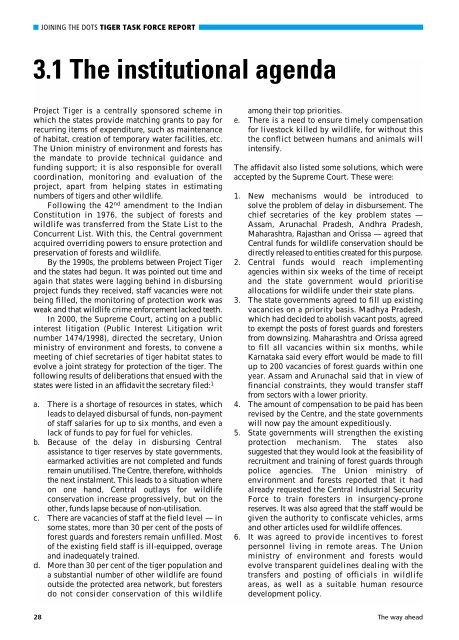Report of the Tiger Task Force - PRS
Report of the Tiger Task Force - PRS
Report of the Tiger Task Force - PRS
Create successful ePaper yourself
Turn your PDF publications into a flip-book with our unique Google optimized e-Paper software.
■ JOINING THE DOTS TIGER TASK FORCE REPORT3.1 The institutional agendaProject <strong>Tiger</strong> is a centrally sponsored scheme inwhich <strong>the</strong> states provide matching grants to pay forrecurring items <strong>of</strong> expenditure, such as maintenance<strong>of</strong> habitat, creation <strong>of</strong> temporary water facilities, etc.The Union ministry <strong>of</strong> environment and forests has<strong>the</strong> mandate to provide technical guidance andfunding support; it is also responsible for overallcoordination, monitoring and evaluation <strong>of</strong> <strong>the</strong>project, apart from helping states in estimatingnumbers <strong>of</strong> tigers and o<strong>the</strong>r wildlife.Following <strong>the</strong> 42 nd amendment to <strong>the</strong> IndianConstitution in 1976, <strong>the</strong> subject <strong>of</strong> forests andwildlife was transferred from <strong>the</strong> State List to <strong>the</strong>Concurrent List. With this, <strong>the</strong> Central governmentacquired overriding powers to ensure protection andpreservation <strong>of</strong> forests and wildlife.By <strong>the</strong> 1990s, <strong>the</strong> problems between Project <strong>Tiger</strong>and <strong>the</strong> states had begun. It was pointed out time andagain that states were lagging behind in disbursingproject funds <strong>the</strong>y received, staff vacancies were notbeing filled, <strong>the</strong> monitoring <strong>of</strong> protection work wasweak and that wildlife crime enforcement lacked teeth.In 2000, <strong>the</strong> Supreme Court, acting on a publicinterest litigation (Public Interest Litigation writnumber 1474/1998), directed <strong>the</strong> secretary, Unionministry <strong>of</strong> environment and forests, to convene ameeting <strong>of</strong> chief secretaries <strong>of</strong> tiger habitat states toevolve a joint strategy for protection <strong>of</strong> <strong>the</strong> tiger. Thefollowing results <strong>of</strong> deliberations that ensued with <strong>the</strong>states were listed in an affidavit <strong>the</strong> secretary filed: 1a. There is a shortage <strong>of</strong> resources in states, whichleads to delayed disbursal <strong>of</strong> funds, non-payment<strong>of</strong> staff salaries for up to six months, and even alack <strong>of</strong> funds to pay for fuel for vehicles.b. Because <strong>of</strong> <strong>the</strong> delay in disbursing Centralassistance to tiger reserves by state governments,earmarked activities are not completed and fundsremain unutilised. The Centre, <strong>the</strong>refore, withholds<strong>the</strong> next instalment. This leads to a situation whereon one hand, Central outlays for wildlifeconservation increase progressively, but on <strong>the</strong>o<strong>the</strong>r, funds lapse because <strong>of</strong> non-utilisation.c. There are vacancies <strong>of</strong> staff at <strong>the</strong> field level — insome states, more than 30 per cent <strong>of</strong> <strong>the</strong> posts <strong>of</strong>forest guards and foresters remain unfilled. Most<strong>of</strong> <strong>the</strong> existing field staff is ill-equipped, overageand inadequately trained.d. More than 30 per cent <strong>of</strong> <strong>the</strong> tiger population anda substantial number <strong>of</strong> o<strong>the</strong>r wildlife are foundoutside <strong>the</strong> protected area network, but forestersdo not consider conservation <strong>of</strong> this wildlifeamong <strong>the</strong>ir top priorities.e. There is a need to ensure timely compensationfor livestock killed by wildlife, for without this<strong>the</strong> conflict between humans and animals willintensify.The affidavit also listed some solutions, which wereaccepted by <strong>the</strong> Supreme Court. These were:1. New mechanisms would be introduced tosolve <strong>the</strong> problem <strong>of</strong> delay in disbursement. Thechief secretaries <strong>of</strong> <strong>the</strong> key problem states —Assam, Arunachal Pradesh, Andhra Pradesh,Maharashtra, Rajasthan and Orissa — agreed thatCentral funds for wildlife conservation should bedirectly released to entities created for this purpose.2. Central funds would reach implementingagencies within six weeks <strong>of</strong> <strong>the</strong> time <strong>of</strong> receiptand <strong>the</strong> state government would prioritiseallocations for wildlife under <strong>the</strong>ir state plans.3. The state governments agreed to fill up existingvacancies on a priority basis. Madhya Pradesh,which had decided to abolish vacant posts, agreedto exempt <strong>the</strong> posts <strong>of</strong> forest guards and forestersfrom downsizing. Maharashtra and Orissa agreedto fill all vacancies within six months, whileKarnataka said every effort would be made to fillup to 200 vacancies <strong>of</strong> forest guards within oneyear. Assam and Arunachal said that in view <strong>of</strong>financial constraints, <strong>the</strong>y would transfer stafffrom sectors with a lower priority.4. The amount <strong>of</strong> compensation to be paid has beenrevised by <strong>the</strong> Centre, and <strong>the</strong> state governmentswill now pay <strong>the</strong> amount expeditiously.5. State governments will streng<strong>the</strong>n <strong>the</strong> existingprotection mechanism. The states alsosuggested that <strong>the</strong>y would look at <strong>the</strong> feasibility <strong>of</strong>recruitment and training <strong>of</strong> forest guards throughpolice agencies. The Union ministry <strong>of</strong>environment and forests reported that it hadalready requested <strong>the</strong> Central Industrial Security<strong>Force</strong> to train foresters in insurgency-pronereserves. It was also agreed that <strong>the</strong> staff would begiven <strong>the</strong> authority to confiscate vehicles, armsand o<strong>the</strong>r articles used for wildlife <strong>of</strong>fences.6. It was agreed to provide incentives to forestpersonnel living in remote areas. The Unionministry <strong>of</strong> environment and forests wouldevolve transparent guidelines dealing with <strong>the</strong>transfers and posting <strong>of</strong> <strong>of</strong>ficials in wildlifeareas, as well as a suitable human resourcedevelopment policy.28 The way ahead
















